ITC548: Telehealth System Analysis and Design for Rural Healthcare
VerifiedAdded on 2023/04/21
|11
|1774
|473
Report
AI Summary
This report presents a comprehensive analysis and design of a Telehealth system aimed at improving healthcare accessibility in rural areas. It begins with an introduction highlighting the government's Telehealth initiative and its objectives. A stakeholder map and list are provided, categorizing stakeholders as operational internal/external and executive internal/external, detailing their roles and interactions within the system. The report includes a questionnaire designed to gather feedback for system development, followed by a detailed use case diagram and description, outlining the processes involved, such as registration, health status updates, report generation, and solution recommendations. The detailed use case section further elaborates on specific scenarios, actors, and pre/post-conditions. The report concludes with a bibliography of cited sources.
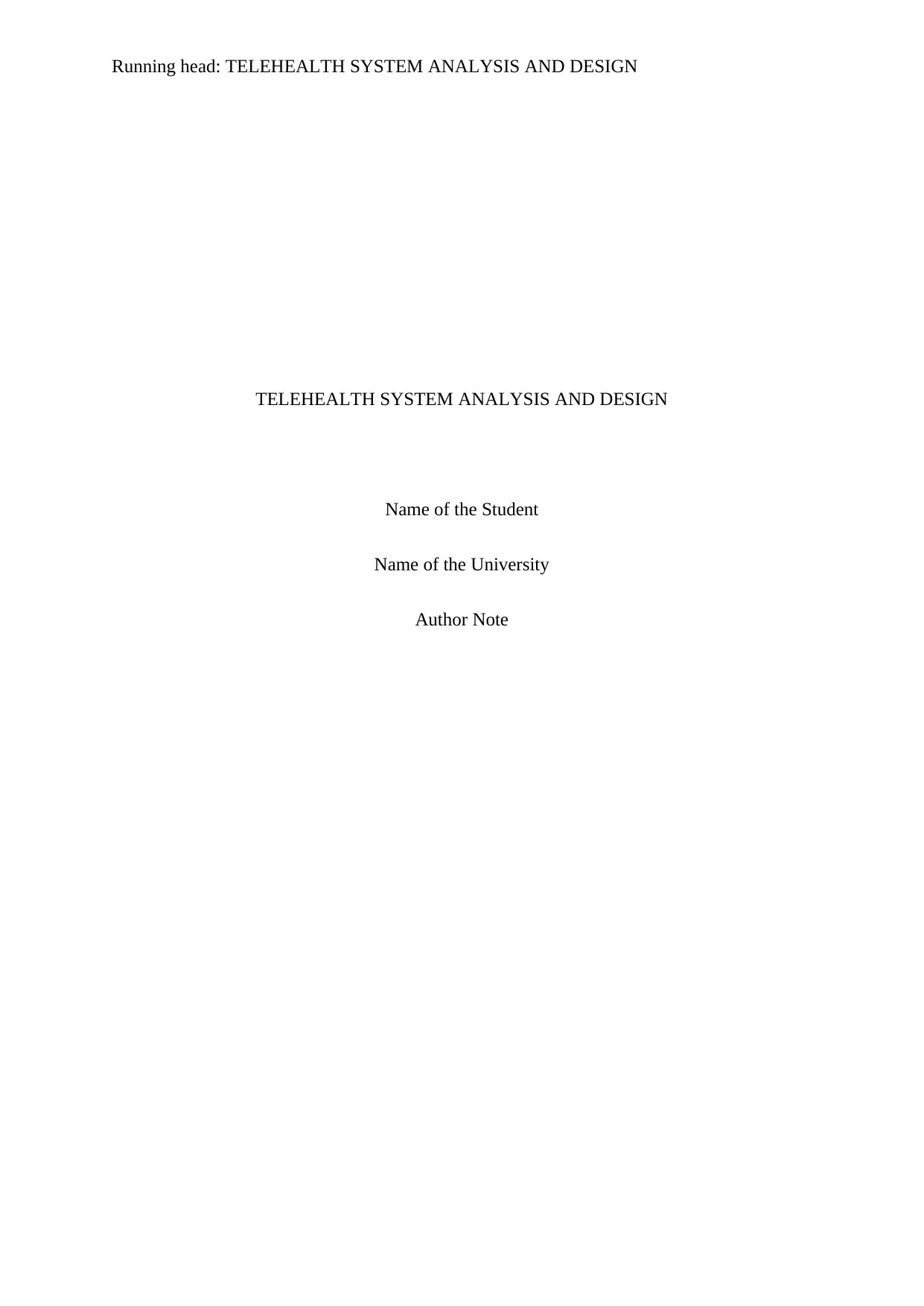
Running head: TELEHEALTH SYSTEM ANALYSIS AND DESIGN
TELEHEALTH SYSTEM ANALYSIS AND DESIGN
Name of the Student
Name of the University
Author Note
TELEHEALTH SYSTEM ANALYSIS AND DESIGN
Name of the Student
Name of the University
Author Note
Paraphrase This Document
Need a fresh take? Get an instant paraphrase of this document with our AI Paraphraser
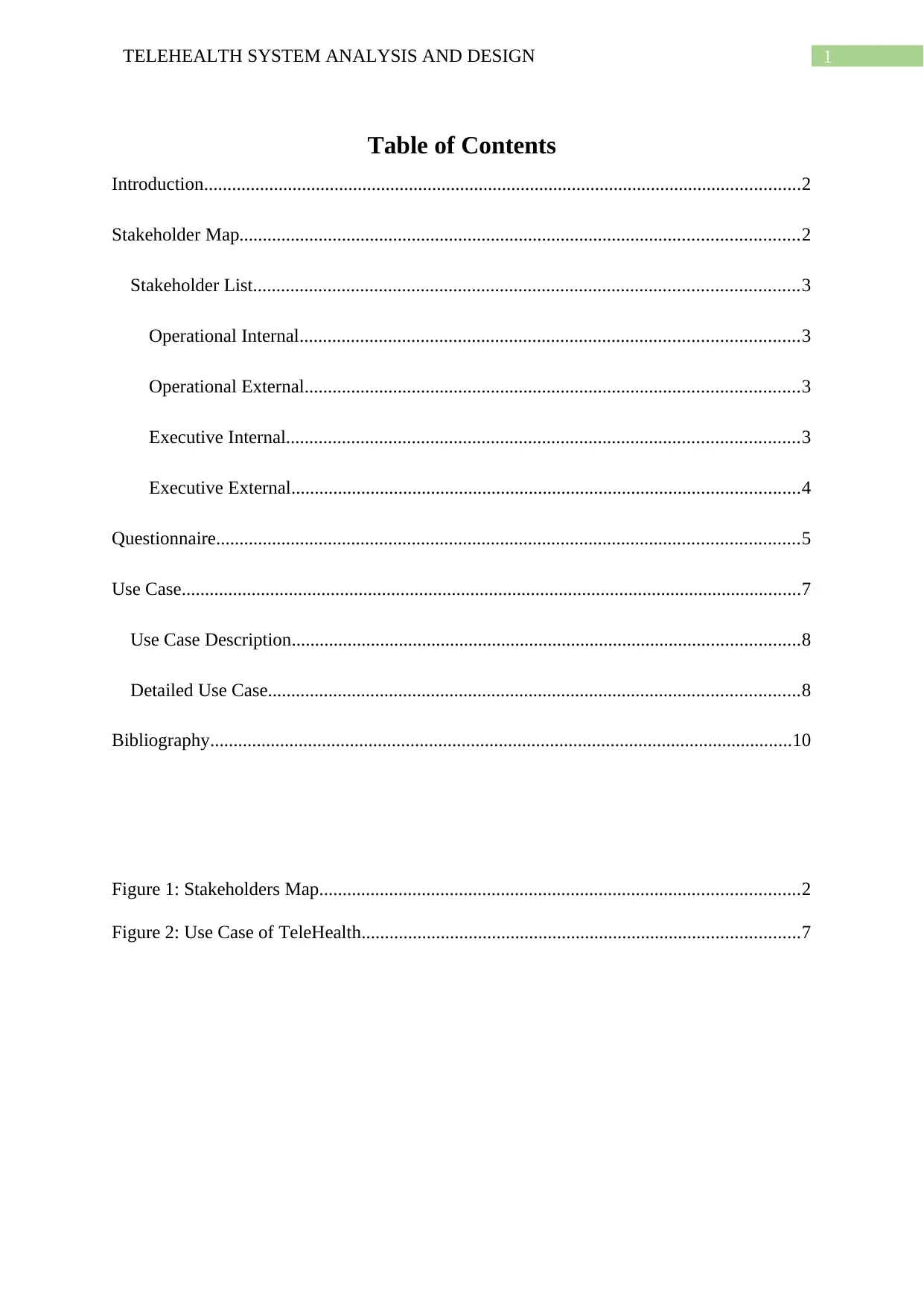
1TELEHEALTH SYSTEM ANALYSIS AND DESIGN
Table of Contents
Introduction................................................................................................................................2
Stakeholder Map........................................................................................................................2
Stakeholder List.....................................................................................................................3
Operational Internal...........................................................................................................3
Operational External..........................................................................................................3
Executive Internal..............................................................................................................3
Executive External.............................................................................................................4
Questionnaire.............................................................................................................................5
Use Case.....................................................................................................................................7
Use Case Description.............................................................................................................8
Detailed Use Case..................................................................................................................8
Bibliography.............................................................................................................................10
Figure 1: Stakeholders Map.......................................................................................................2
Figure 2: Use Case of TeleHealth..............................................................................................7
Table of Contents
Introduction................................................................................................................................2
Stakeholder Map........................................................................................................................2
Stakeholder List.....................................................................................................................3
Operational Internal...........................................................................................................3
Operational External..........................................................................................................3
Executive Internal..............................................................................................................3
Executive External.............................................................................................................4
Questionnaire.............................................................................................................................5
Use Case.....................................................................................................................................7
Use Case Description.............................................................................................................8
Detailed Use Case..................................................................................................................8
Bibliography.............................................................................................................................10
Figure 1: Stakeholders Map.......................................................................................................2
Figure 2: Use Case of TeleHealth..............................................................................................7
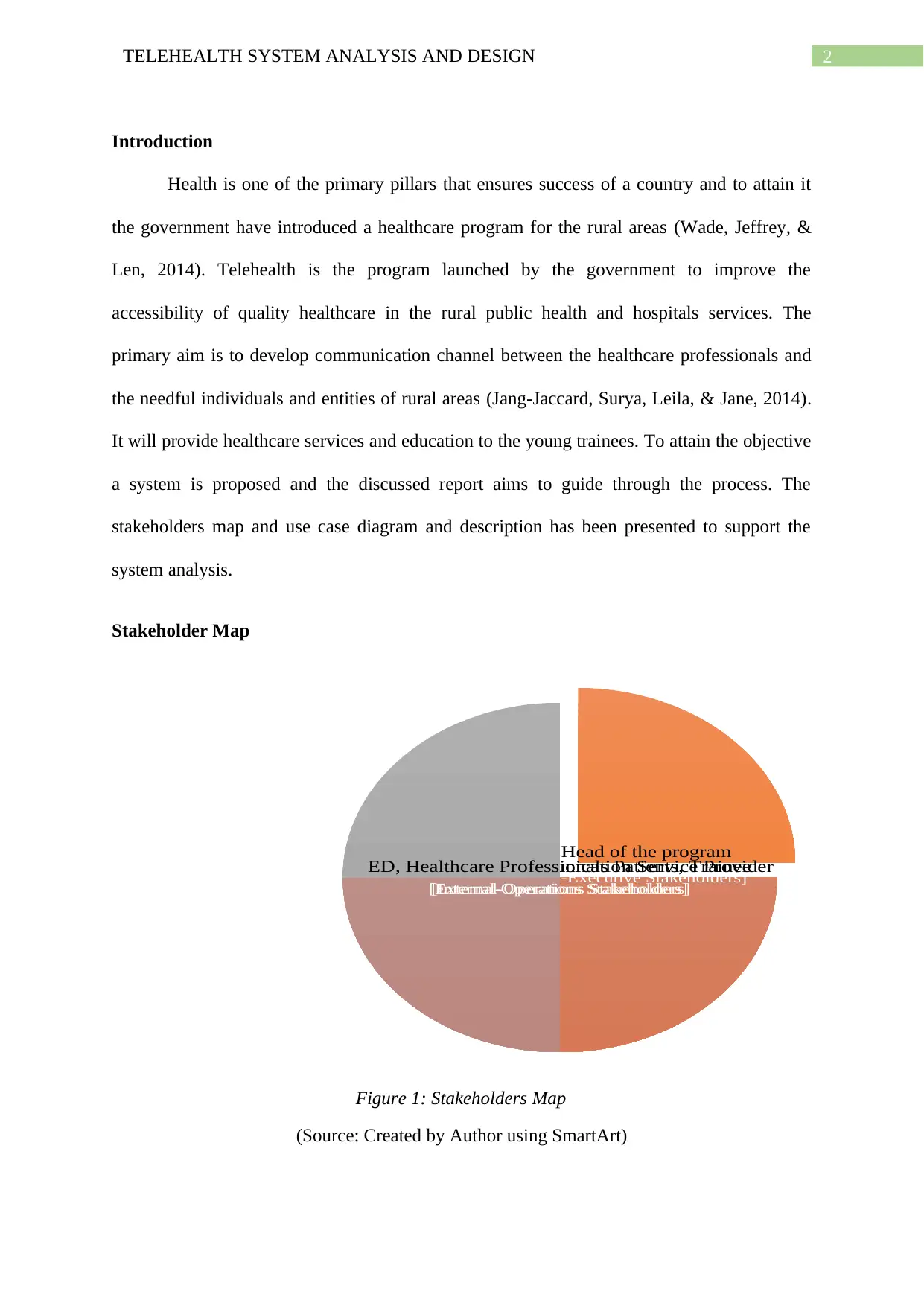
2TELEHEALTH SYSTEM ANALYSIS AND DESIGN
Introduction
Health is one of the primary pillars that ensures success of a country and to attain it
the government have introduced a healthcare program for the rural areas (Wade, Jeffrey, &
Len, 2014). Telehealth is the program launched by the government to improve the
accessibility of quality healthcare in the rural public health and hospitals services. The
primary aim is to develop communication channel between the healthcare professionals and
the needful individuals and entities of rural areas (Jang-Jaccard, Surya, Leila, & Jane, 2014).
It will provide healthcare services and education to the young trainees. To attain the objective
a system is proposed and the discussed report aims to guide through the process. The
stakeholders map and use case diagram and description has been presented to support the
system analysis.
Stakeholder Map
Figure 1: Stakeholders Map
(Source: Created by Author using SmartArt)
Program owner, Head of the program
[External-Executive Stakeholders]Administrator, [Internal-Executive Stakeholders]
Hospital Services, Communication Service Provider
[External-Operations Stakeholders]
ED, Healthcare Professionals Patients, Trainee
[Internal-Operations Stakeholders]
Introduction
Health is one of the primary pillars that ensures success of a country and to attain it
the government have introduced a healthcare program for the rural areas (Wade, Jeffrey, &
Len, 2014). Telehealth is the program launched by the government to improve the
accessibility of quality healthcare in the rural public health and hospitals services. The
primary aim is to develop communication channel between the healthcare professionals and
the needful individuals and entities of rural areas (Jang-Jaccard, Surya, Leila, & Jane, 2014).
It will provide healthcare services and education to the young trainees. To attain the objective
a system is proposed and the discussed report aims to guide through the process. The
stakeholders map and use case diagram and description has been presented to support the
system analysis.
Stakeholder Map
Figure 1: Stakeholders Map
(Source: Created by Author using SmartArt)
Program owner, Head of the program
[External-Executive Stakeholders]Administrator, [Internal-Executive Stakeholders]
Hospital Services, Communication Service Provider
[External-Operations Stakeholders]
ED, Healthcare Professionals Patients, Trainee
[Internal-Operations Stakeholders]
⊘ This is a preview!⊘
Do you want full access?
Subscribe today to unlock all pages.

Trusted by 1+ million students worldwide
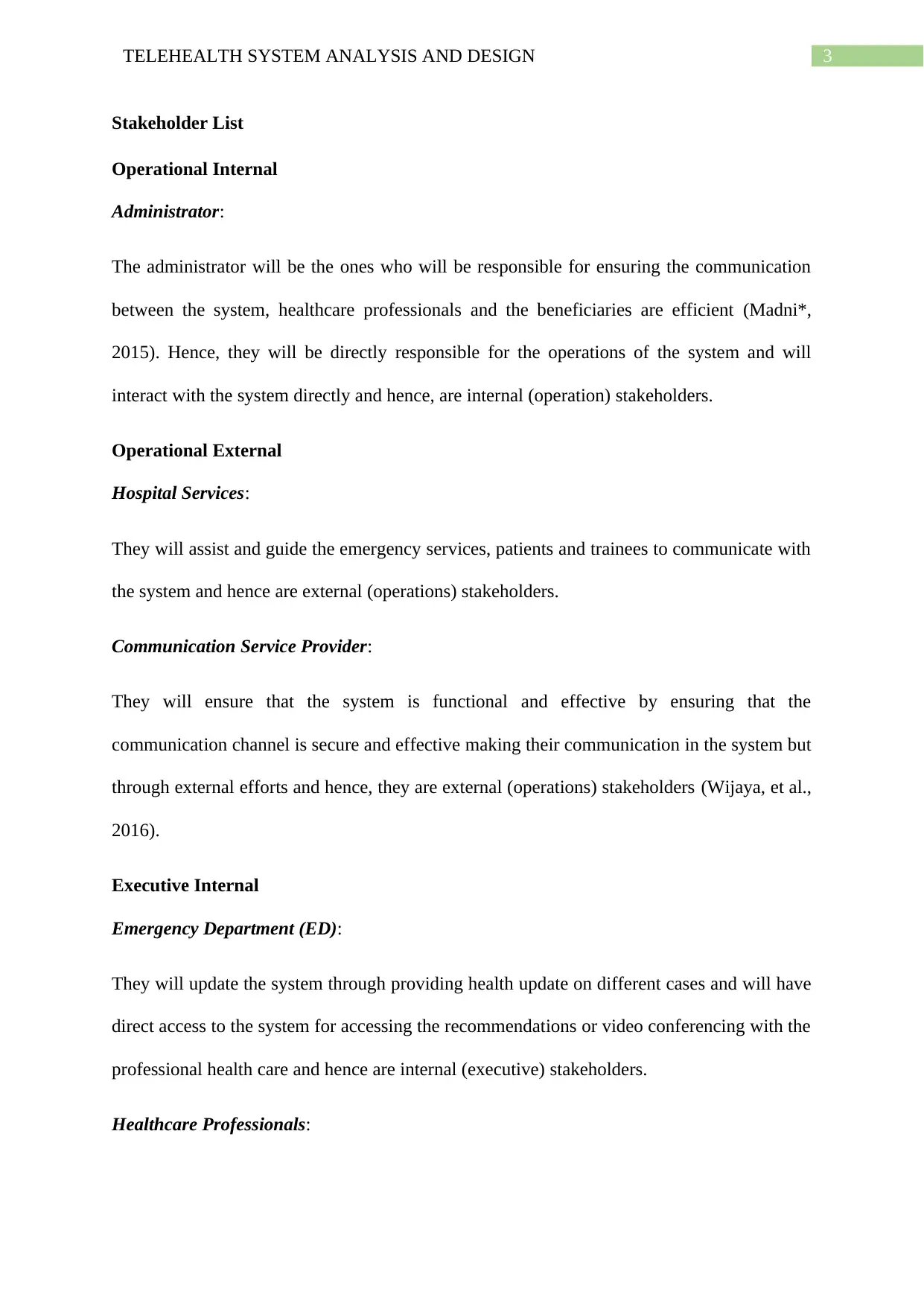
3TELEHEALTH SYSTEM ANALYSIS AND DESIGN
Stakeholder List
Operational Internal
Administrator:
The administrator will be the ones who will be responsible for ensuring the communication
between the system, healthcare professionals and the beneficiaries are efficient (Madni*,
2015). Hence, they will be directly responsible for the operations of the system and will
interact with the system directly and hence, are internal (operation) stakeholders.
Operational External
Hospital Services:
They will assist and guide the emergency services, patients and trainees to communicate with
the system and hence are external (operations) stakeholders.
Communication Service Provider:
They will ensure that the system is functional and effective by ensuring that the
communication channel is secure and effective making their communication in the system but
through external efforts and hence, they are external (operations) stakeholders (Wijaya, et al.,
2016).
Executive Internal
Emergency Department (ED):
They will update the system through providing health update on different cases and will have
direct access to the system for accessing the recommendations or video conferencing with the
professional health care and hence are internal (executive) stakeholders.
Healthcare Professionals:
Stakeholder List
Operational Internal
Administrator:
The administrator will be the ones who will be responsible for ensuring the communication
between the system, healthcare professionals and the beneficiaries are efficient (Madni*,
2015). Hence, they will be directly responsible for the operations of the system and will
interact with the system directly and hence, are internal (operation) stakeholders.
Operational External
Hospital Services:
They will assist and guide the emergency services, patients and trainees to communicate with
the system and hence are external (operations) stakeholders.
Communication Service Provider:
They will ensure that the system is functional and effective by ensuring that the
communication channel is secure and effective making their communication in the system but
through external efforts and hence, they are external (operations) stakeholders (Wijaya, et al.,
2016).
Executive Internal
Emergency Department (ED):
They will update the system through providing health update on different cases and will have
direct access to the system for accessing the recommendations or video conferencing with the
professional health care and hence are internal (executive) stakeholders.
Healthcare Professionals:
Paraphrase This Document
Need a fresh take? Get an instant paraphrase of this document with our AI Paraphraser
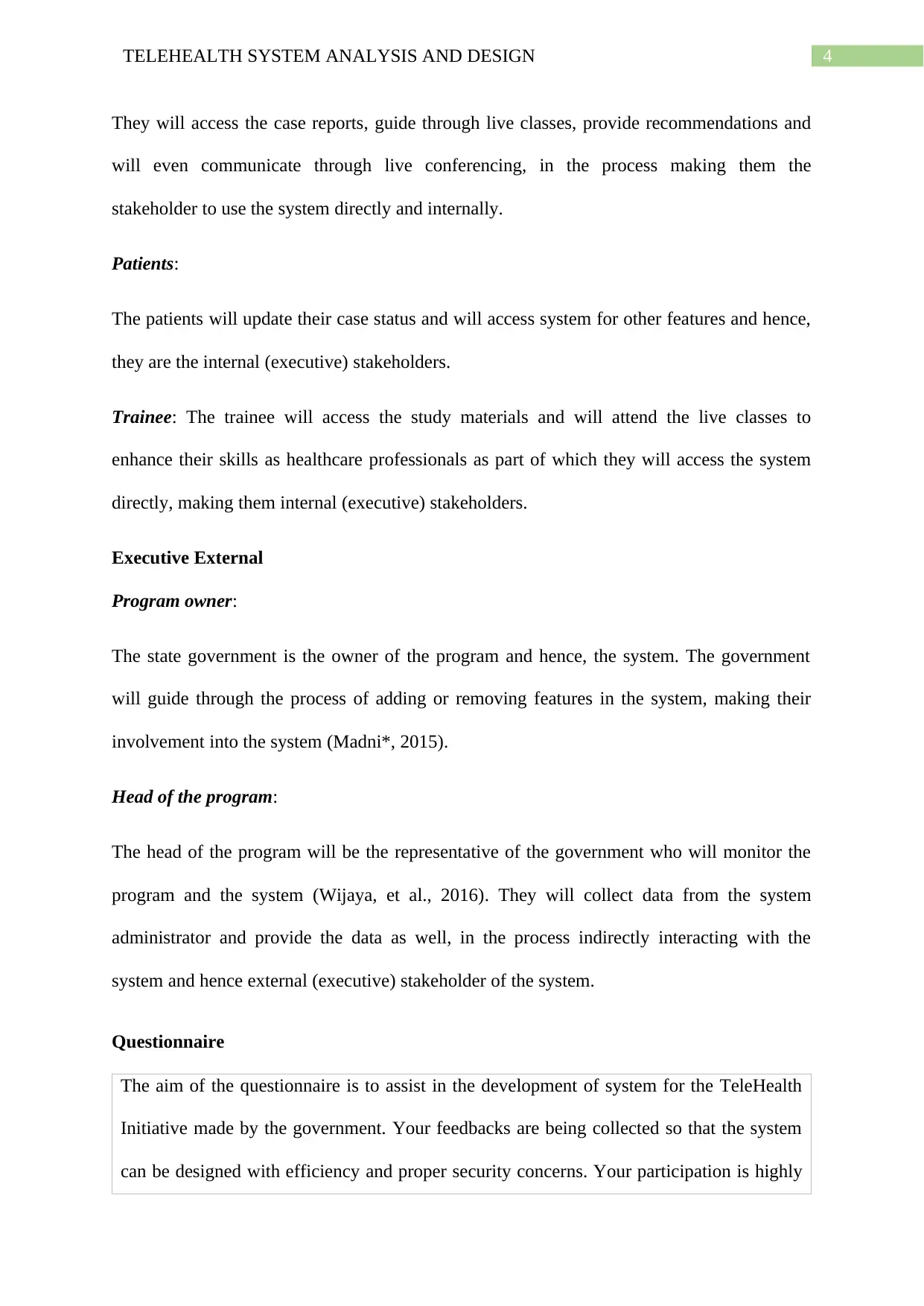
4TELEHEALTH SYSTEM ANALYSIS AND DESIGN
They will access the case reports, guide through live classes, provide recommendations and
will even communicate through live conferencing, in the process making them the
stakeholder to use the system directly and internally.
Patients:
The patients will update their case status and will access system for other features and hence,
they are the internal (executive) stakeholders.
Trainee: The trainee will access the study materials and will attend the live classes to
enhance their skills as healthcare professionals as part of which they will access the system
directly, making them internal (executive) stakeholders.
Executive External
Program owner:
The state government is the owner of the program and hence, the system. The government
will guide through the process of adding or removing features in the system, making their
involvement into the system (Madni*, 2015).
Head of the program:
The head of the program will be the representative of the government who will monitor the
program and the system (Wijaya, et al., 2016). They will collect data from the system
administrator and provide the data as well, in the process indirectly interacting with the
system and hence external (executive) stakeholder of the system.
Questionnaire
The aim of the questionnaire is to assist in the development of system for the TeleHealth
Initiative made by the government. Your feedbacks are being collected so that the system
can be designed with efficiency and proper security concerns. Your participation is highly
They will access the case reports, guide through live classes, provide recommendations and
will even communicate through live conferencing, in the process making them the
stakeholder to use the system directly and internally.
Patients:
The patients will update their case status and will access system for other features and hence,
they are the internal (executive) stakeholders.
Trainee: The trainee will access the study materials and will attend the live classes to
enhance their skills as healthcare professionals as part of which they will access the system
directly, making them internal (executive) stakeholders.
Executive External
Program owner:
The state government is the owner of the program and hence, the system. The government
will guide through the process of adding or removing features in the system, making their
involvement into the system (Madni*, 2015).
Head of the program:
The head of the program will be the representative of the government who will monitor the
program and the system (Wijaya, et al., 2016). They will collect data from the system
administrator and provide the data as well, in the process indirectly interacting with the
system and hence external (executive) stakeholder of the system.
Questionnaire
The aim of the questionnaire is to assist in the development of system for the TeleHealth
Initiative made by the government. Your feedbacks are being collected so that the system
can be designed with efficiency and proper security concerns. Your participation is highly
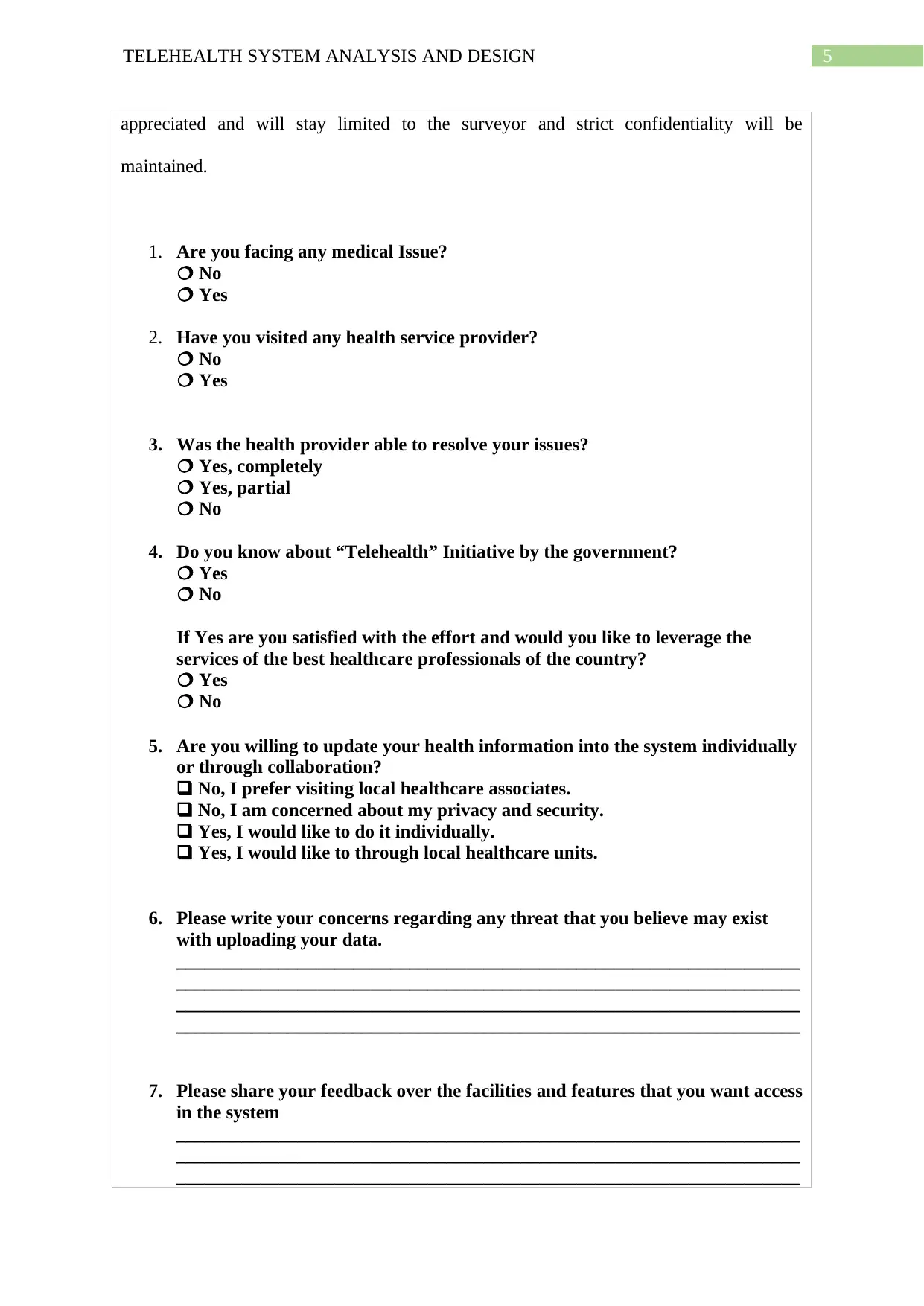
5TELEHEALTH SYSTEM ANALYSIS AND DESIGN
appreciated and will stay limited to the surveyor and strict confidentiality will be
maintained.
1. Are you facing any medical Issue?
No
Yes
2. Have you visited any health service provider?
No
Yes
3. Was the health provider able to resolve your issues?
Yes, completely
Yes, partial
No
4. Do you know about “Telehealth” Initiative by the government?
Yes
No
If Yes are you satisfied with the effort and would you like to leverage the
services of the best healthcare professionals of the country?
Yes
No
5. Are you willing to update your health information into the system individually
or through collaboration?
No, I prefer visiting local healthcare associates.
No, I am concerned about my privacy and security.
Yes, I would like to do it individually.
Yes, I would like to through local healthcare units.
6. Please write your concerns regarding any threat that you believe may exist
with uploading your data.
___________________________________________________________________
___________________________________________________________________
___________________________________________________________________
___________________________________________________________________
7. Please share your feedback over the facilities and features that you want access
in the system
___________________________________________________________________
___________________________________________________________________
___________________________________________________________________
appreciated and will stay limited to the surveyor and strict confidentiality will be
maintained.
1. Are you facing any medical Issue?
No
Yes
2. Have you visited any health service provider?
No
Yes
3. Was the health provider able to resolve your issues?
Yes, completely
Yes, partial
No
4. Do you know about “Telehealth” Initiative by the government?
Yes
No
If Yes are you satisfied with the effort and would you like to leverage the
services of the best healthcare professionals of the country?
Yes
No
5. Are you willing to update your health information into the system individually
or through collaboration?
No, I prefer visiting local healthcare associates.
No, I am concerned about my privacy and security.
Yes, I would like to do it individually.
Yes, I would like to through local healthcare units.
6. Please write your concerns regarding any threat that you believe may exist
with uploading your data.
___________________________________________________________________
___________________________________________________________________
___________________________________________________________________
___________________________________________________________________
7. Please share your feedback over the facilities and features that you want access
in the system
___________________________________________________________________
___________________________________________________________________
___________________________________________________________________
⊘ This is a preview!⊘
Do you want full access?
Subscribe today to unlock all pages.

Trusted by 1+ million students worldwide
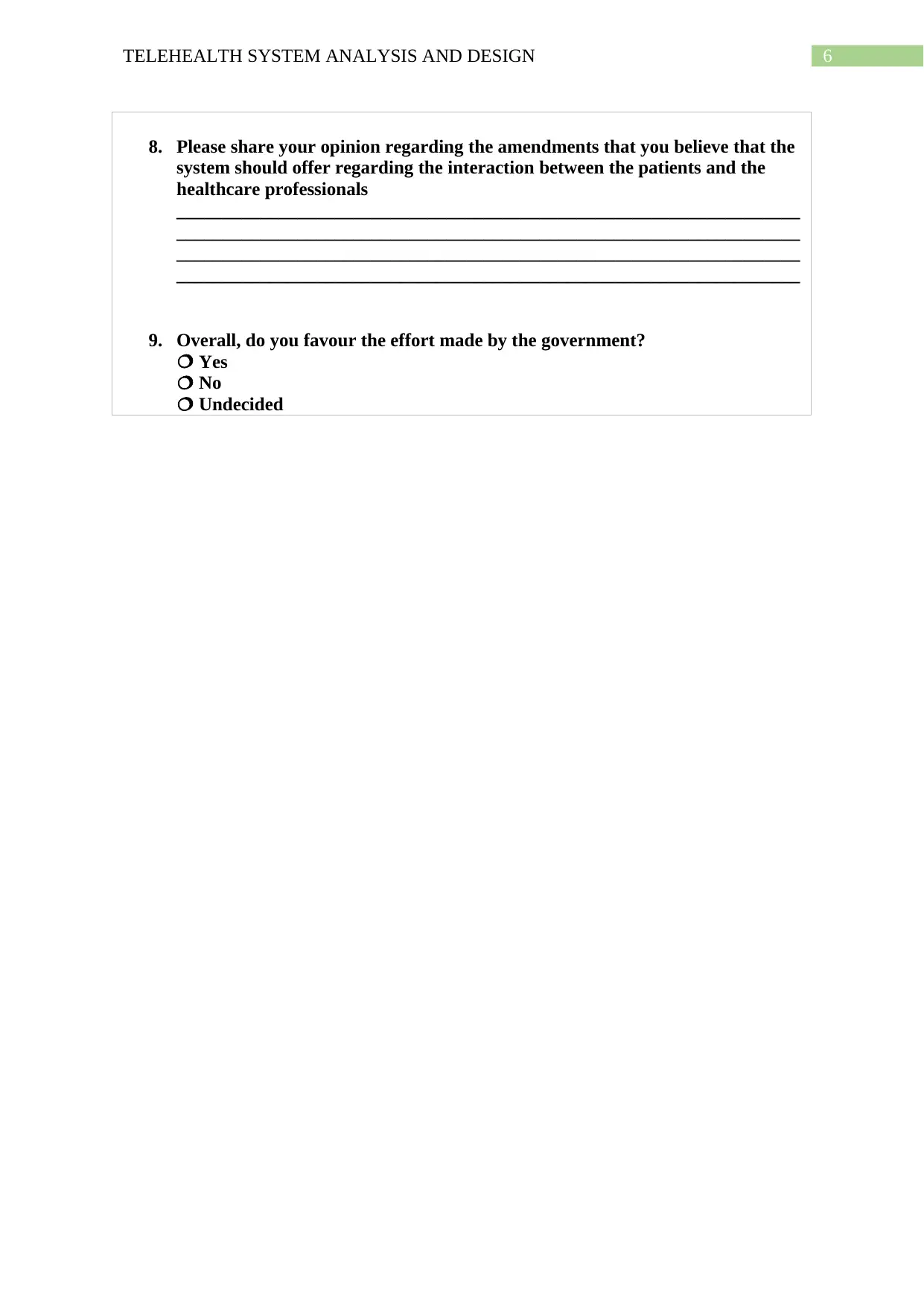
6TELEHEALTH SYSTEM ANALYSIS AND DESIGN
8. Please share your opinion regarding the amendments that you believe that the
system should offer regarding the interaction between the patients and the
healthcare professionals
___________________________________________________________________
___________________________________________________________________
___________________________________________________________________
___________________________________________________________________
9. Overall, do you favour the effort made by the government?
Yes
No
Undecided
8. Please share your opinion regarding the amendments that you believe that the
system should offer regarding the interaction between the patients and the
healthcare professionals
___________________________________________________________________
___________________________________________________________________
___________________________________________________________________
___________________________________________________________________
9. Overall, do you favour the effort made by the government?
Yes
No
Undecided
Paraphrase This Document
Need a fresh take? Get an instant paraphrase of this document with our AI Paraphraser
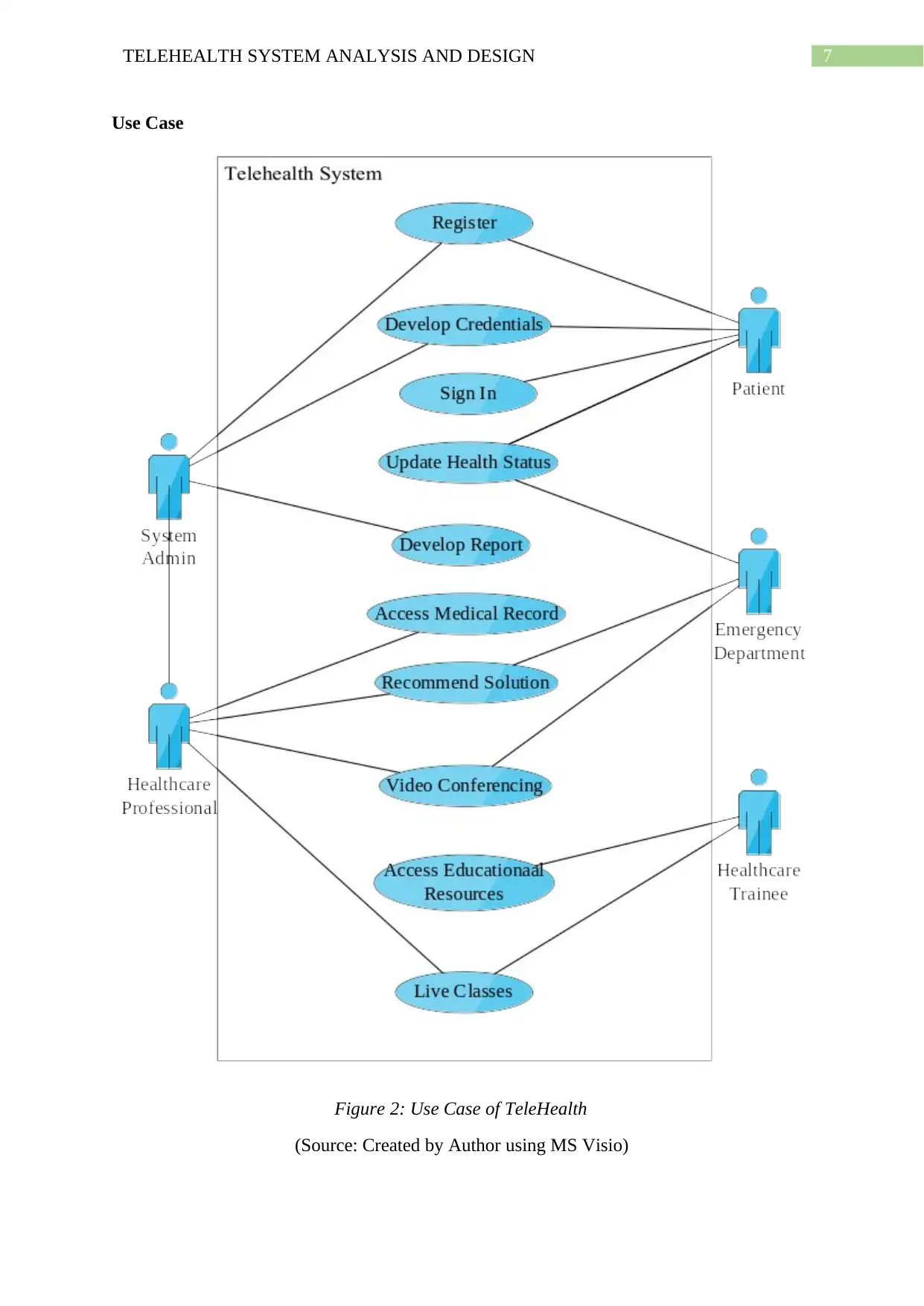
7TELEHEALTH SYSTEM ANALYSIS AND DESIGN
Use Case
Figure 2: Use Case of TeleHealth
(Source: Created by Author using MS Visio)
Use Case
Figure 2: Use Case of TeleHealth
(Source: Created by Author using MS Visio)
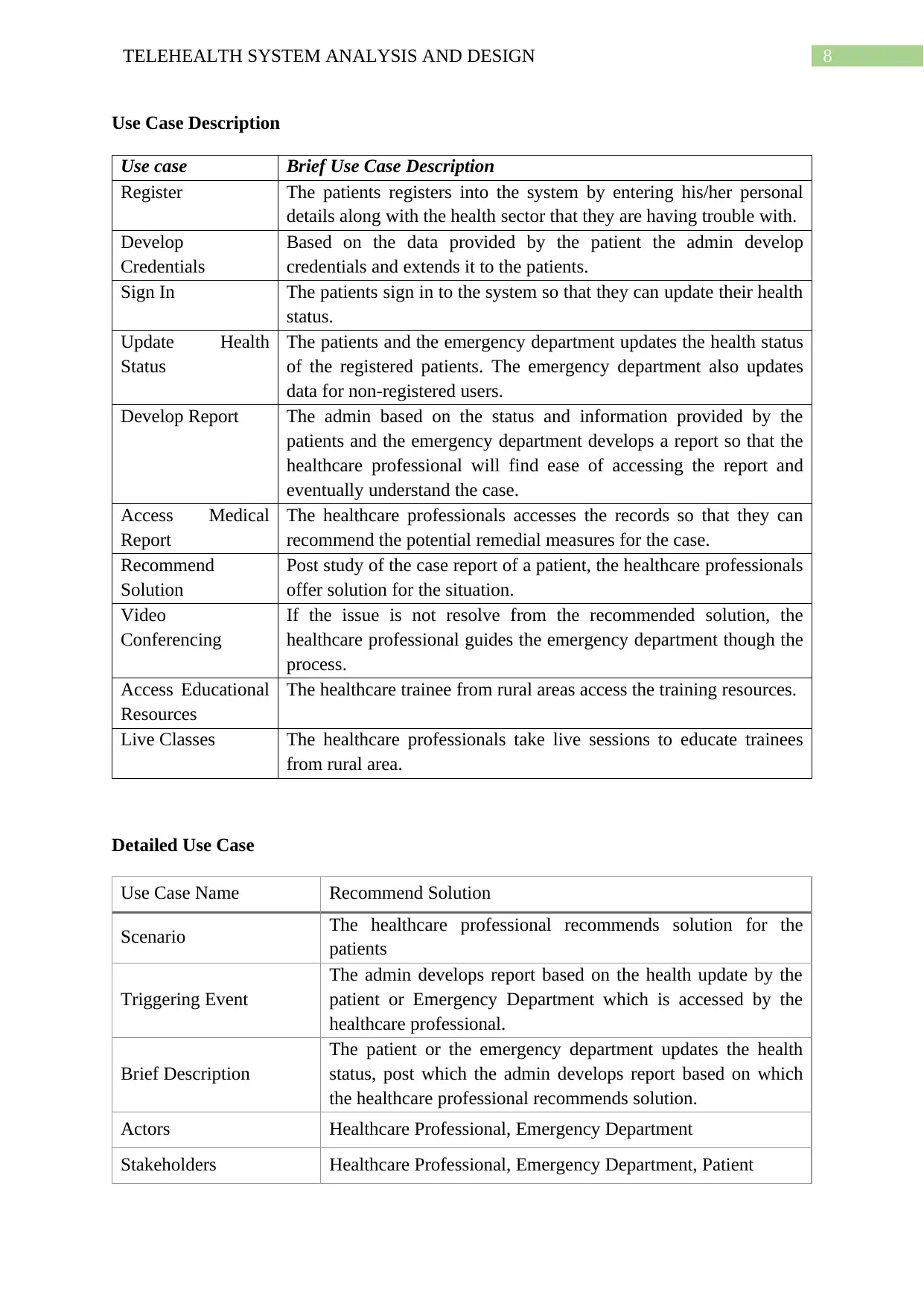
8TELEHEALTH SYSTEM ANALYSIS AND DESIGN
Use Case Description
Use case Brief Use Case Description
Register The patients registers into the system by entering his/her personal
details along with the health sector that they are having trouble with.
Develop
Credentials
Based on the data provided by the patient the admin develop
credentials and extends it to the patients.
Sign In The patients sign in to the system so that they can update their health
status.
Update Health
Status
The patients and the emergency department updates the health status
of the registered patients. The emergency department also updates
data for non-registered users.
Develop Report The admin based on the status and information provided by the
patients and the emergency department develops a report so that the
healthcare professional will find ease of accessing the report and
eventually understand the case.
Access Medical
Report
The healthcare professionals accesses the records so that they can
recommend the potential remedial measures for the case.
Recommend
Solution
Post study of the case report of a patient, the healthcare professionals
offer solution for the situation.
Video
Conferencing
If the issue is not resolve from the recommended solution, the
healthcare professional guides the emergency department though the
process.
Access Educational
Resources
The healthcare trainee from rural areas access the training resources.
Live Classes The healthcare professionals take live sessions to educate trainees
from rural area.
Detailed Use Case
Use Case Name Recommend Solution
Scenario The healthcare professional recommends solution for the
patients
Triggering Event
The admin develops report based on the health update by the
patient or Emergency Department which is accessed by the
healthcare professional.
Brief Description
The patient or the emergency department updates the health
status, post which the admin develops report based on which
the healthcare professional recommends solution.
Actors Healthcare Professional, Emergency Department
Stakeholders Healthcare Professional, Emergency Department, Patient
Use Case Description
Use case Brief Use Case Description
Register The patients registers into the system by entering his/her personal
details along with the health sector that they are having trouble with.
Develop
Credentials
Based on the data provided by the patient the admin develop
credentials and extends it to the patients.
Sign In The patients sign in to the system so that they can update their health
status.
Update Health
Status
The patients and the emergency department updates the health status
of the registered patients. The emergency department also updates
data for non-registered users.
Develop Report The admin based on the status and information provided by the
patients and the emergency department develops a report so that the
healthcare professional will find ease of accessing the report and
eventually understand the case.
Access Medical
Report
The healthcare professionals accesses the records so that they can
recommend the potential remedial measures for the case.
Recommend
Solution
Post study of the case report of a patient, the healthcare professionals
offer solution for the situation.
Video
Conferencing
If the issue is not resolve from the recommended solution, the
healthcare professional guides the emergency department though the
process.
Access Educational
Resources
The healthcare trainee from rural areas access the training resources.
Live Classes The healthcare professionals take live sessions to educate trainees
from rural area.
Detailed Use Case
Use Case Name Recommend Solution
Scenario The healthcare professional recommends solution for the
patients
Triggering Event
The admin develops report based on the health update by the
patient or Emergency Department which is accessed by the
healthcare professional.
Brief Description
The patient or the emergency department updates the health
status, post which the admin develops report based on which
the healthcare professional recommends solution.
Actors Healthcare Professional, Emergency Department
Stakeholders Healthcare Professional, Emergency Department, Patient
⊘ This is a preview!⊘
Do you want full access?
Subscribe today to unlock all pages.

Trusted by 1+ million students worldwide
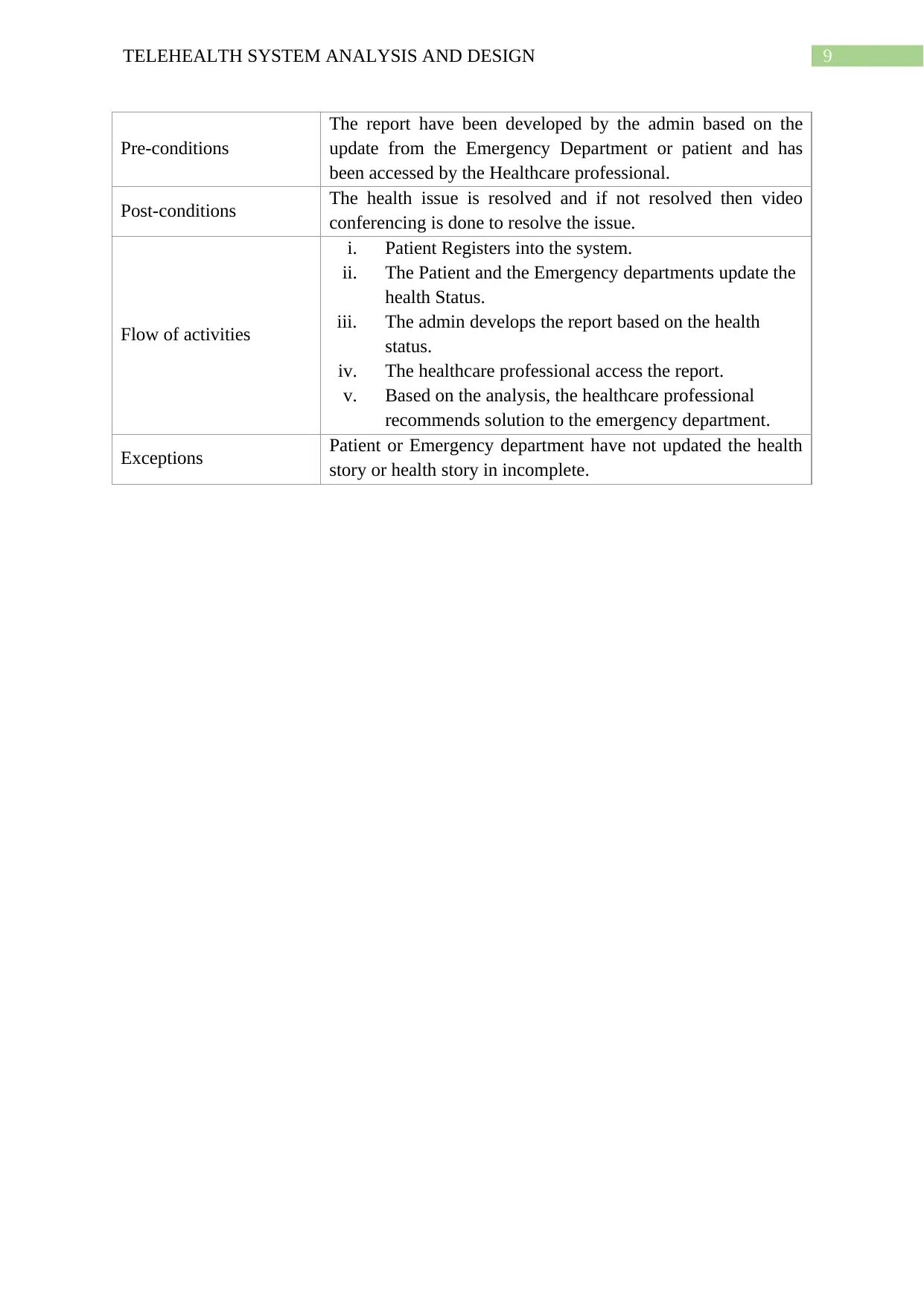
9TELEHEALTH SYSTEM ANALYSIS AND DESIGN
Pre-conditions
The report have been developed by the admin based on the
update from the Emergency Department or patient and has
been accessed by the Healthcare professional.
Post-conditions The health issue is resolved and if not resolved then video
conferencing is done to resolve the issue.
Flow of activities
i. Patient Registers into the system.
ii. The Patient and the Emergency departments update the
health Status.
iii. The admin develops the report based on the health
status.
iv. The healthcare professional access the report.
v. Based on the analysis, the healthcare professional
recommends solution to the emergency department.
Exceptions Patient or Emergency department have not updated the health
story or health story in incomplete.
Pre-conditions
The report have been developed by the admin based on the
update from the Emergency Department or patient and has
been accessed by the Healthcare professional.
Post-conditions The health issue is resolved and if not resolved then video
conferencing is done to resolve the issue.
Flow of activities
i. Patient Registers into the system.
ii. The Patient and the Emergency departments update the
health Status.
iii. The admin develops the report based on the health
status.
iv. The healthcare professional access the report.
v. Based on the analysis, the healthcare professional
recommends solution to the emergency department.
Exceptions Patient or Emergency department have not updated the health
story or health story in incomplete.
Paraphrase This Document
Need a fresh take? Get an instant paraphrase of this document with our AI Paraphraser
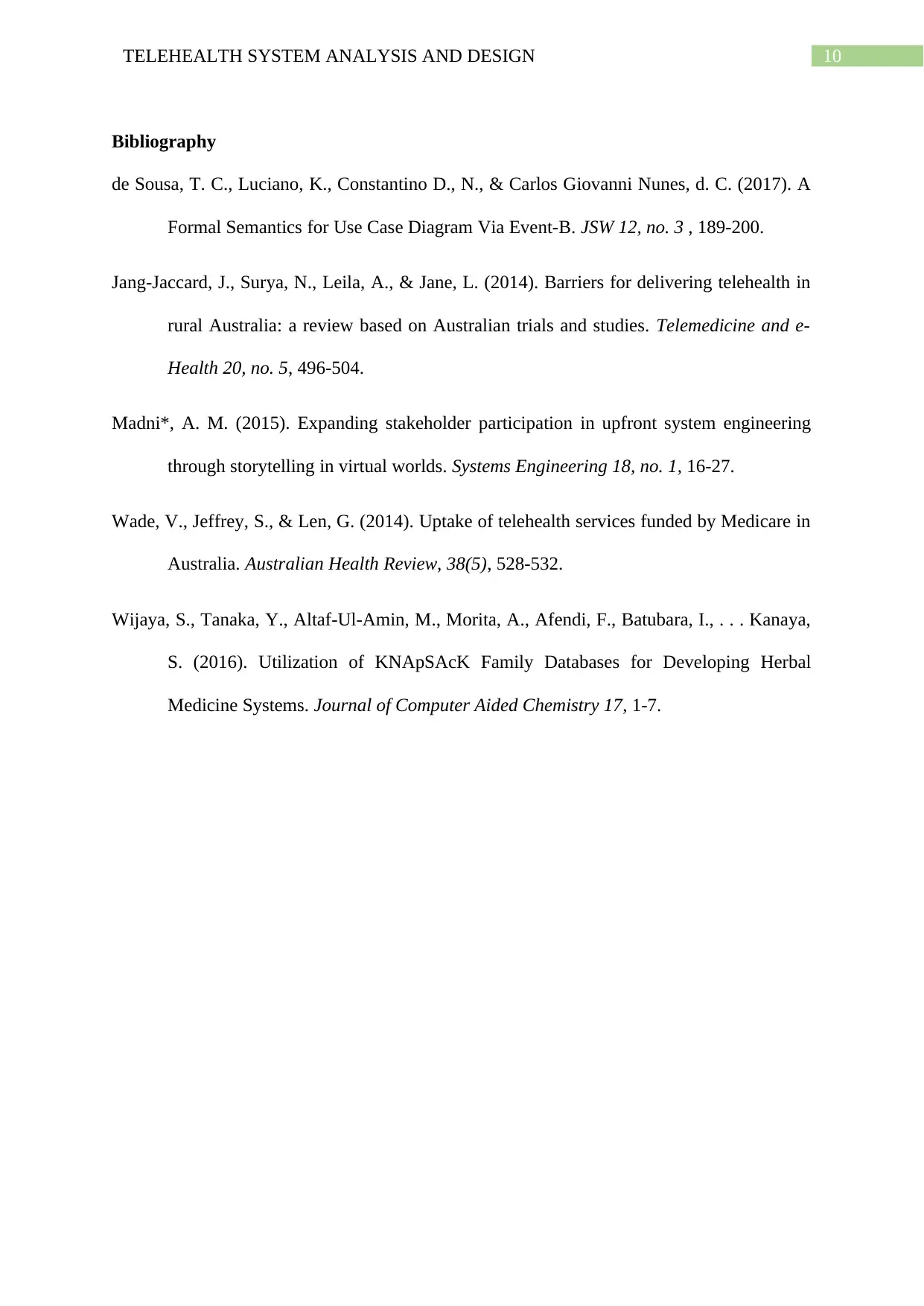
10TELEHEALTH SYSTEM ANALYSIS AND DESIGN
Bibliography
de Sousa, T. C., Luciano, K., Constantino D., N., & Carlos Giovanni Nunes, d. C. (2017). A
Formal Semantics for Use Case Diagram Via Event-B. JSW 12, no. 3 , 189-200.
Jang-Jaccard, J., Surya, N., Leila, A., & Jane, L. (2014). Barriers for delivering telehealth in
rural Australia: a review based on Australian trials and studies. Telemedicine and e-
Health 20, no. 5, 496-504.
Madni*, A. M. (2015). Expanding stakeholder participation in upfront system engineering
through storytelling in virtual worlds. Systems Engineering 18, no. 1, 16-27.
Wade, V., Jeffrey, S., & Len, G. (2014). Uptake of telehealth services funded by Medicare in
Australia. Australian Health Review, 38(5), 528-532.
Wijaya, S., Tanaka, Y., Altaf-Ul-Amin, M., Morita, A., Afendi, F., Batubara, I., . . . Kanaya,
S. (2016). Utilization of KNApSAcK Family Databases for Developing Herbal
Medicine Systems. Journal of Computer Aided Chemistry 17, 1-7.
Bibliography
de Sousa, T. C., Luciano, K., Constantino D., N., & Carlos Giovanni Nunes, d. C. (2017). A
Formal Semantics for Use Case Diagram Via Event-B. JSW 12, no. 3 , 189-200.
Jang-Jaccard, J., Surya, N., Leila, A., & Jane, L. (2014). Barriers for delivering telehealth in
rural Australia: a review based on Australian trials and studies. Telemedicine and e-
Health 20, no. 5, 496-504.
Madni*, A. M. (2015). Expanding stakeholder participation in upfront system engineering
through storytelling in virtual worlds. Systems Engineering 18, no. 1, 16-27.
Wade, V., Jeffrey, S., & Len, G. (2014). Uptake of telehealth services funded by Medicare in
Australia. Australian Health Review, 38(5), 528-532.
Wijaya, S., Tanaka, Y., Altaf-Ul-Amin, M., Morita, A., Afendi, F., Batubara, I., . . . Kanaya,
S. (2016). Utilization of KNApSAcK Family Databases for Developing Herbal
Medicine Systems. Journal of Computer Aided Chemistry 17, 1-7.
1 out of 11
Related Documents
Your All-in-One AI-Powered Toolkit for Academic Success.
+13062052269
info@desklib.com
Available 24*7 on WhatsApp / Email
![[object Object]](/_next/static/media/star-bottom.7253800d.svg)
Unlock your academic potential
Copyright © 2020–2025 A2Z Services. All Rights Reserved. Developed and managed by ZUCOL.




